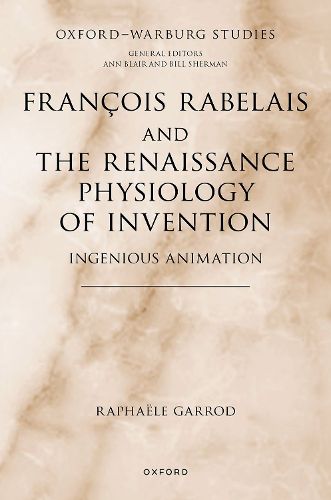Readings Newsletter
Become a Readings Member to make your shopping experience even easier.
Sign in or sign up for free!
You’re not far away from qualifying for FREE standard shipping within Australia
You’ve qualified for FREE standard shipping within Australia
The cart is loading…






Francois Rabelais and the Renaissance Physiology of Invention: Ingenious Animation explores the medical poetics of inventive, embodied thinking or ingenuity instantiated in Rabelais' Gargantua and, mostly,in his Quart livre. It unsettles established dichotomies in Rabelaisian scholarship between Rabelais's 'lowly' laughter and his 'high', erudite message and reassesses the Rabelaisian grotesque by highlighting its debts to grotesque ornament, this marginal yet omnipresent Renaissance visual art. Bodily functions are a trademark of Rabelais's poetics. Scholarship has read them as signs of carnivalesque inversion, in line with the Bakhtinian grotesque, or of satirical degradation: in both instances, the 'lowly' is opposed to the 'high', the belly to the head. Yet for a physician like Rabelais, the 'head' or the brain as the site of cognition is not opposed to what is below it: the chest as the site of breathing, the belly and its nether regions as sites of nutrition and generation. In Renaissance medicine, these are integrated physiological systems whose products fuel each other's operations, including cognition. Read through this lens and alongside his diagnosis of the healthy or diseased culture of his time (rotting scholasticism, the humanist digestion of the classical heritage, or the schismatic convulsions shaking Christianity) Rabelais's fictions testify to his reflexive investigation into how culture results from physiological processes fuelling the inventive ability of the human animal, made manifest in pedagogical, artistic, mechanical, and spiritual 'inventions'. They display the life (rather than the truth) of culture stemming from human ingenia, that is, wits conditioned by biological natures. While these might be idiosyncratic, their animation is fuelled and shaped by the food one eats, the air one breathes, the places one inhabits, the company one keeps. In this respect Rabelaisian fiction is grotesque in a period sense. With its emphasis on hybrid forms capturing the metamorphic powers of animation, grotesque ornament reflexively commented on the embodied inventive processes underpinning Renaissance mimesis. Rabelais's fictions display a similar logic: they foreground the inventive powers of ingenious animation and articulate reflexive, often ironic alternatives to the humanist views they alter: a thoroughly embodied anthropology, a naturalist genealogy of cultural production and transmission, a phantastical account of artistic invention as uncanny liveliness.
$9.00 standard shipping within Australia
FREE standard shipping within Australia for orders over $100.00
Express & International shipping calculated at checkout
Francois Rabelais and the Renaissance Physiology of Invention: Ingenious Animation explores the medical poetics of inventive, embodied thinking or ingenuity instantiated in Rabelais' Gargantua and, mostly,in his Quart livre. It unsettles established dichotomies in Rabelaisian scholarship between Rabelais's 'lowly' laughter and his 'high', erudite message and reassesses the Rabelaisian grotesque by highlighting its debts to grotesque ornament, this marginal yet omnipresent Renaissance visual art. Bodily functions are a trademark of Rabelais's poetics. Scholarship has read them as signs of carnivalesque inversion, in line with the Bakhtinian grotesque, or of satirical degradation: in both instances, the 'lowly' is opposed to the 'high', the belly to the head. Yet for a physician like Rabelais, the 'head' or the brain as the site of cognition is not opposed to what is below it: the chest as the site of breathing, the belly and its nether regions as sites of nutrition and generation. In Renaissance medicine, these are integrated physiological systems whose products fuel each other's operations, including cognition. Read through this lens and alongside his diagnosis of the healthy or diseased culture of his time (rotting scholasticism, the humanist digestion of the classical heritage, or the schismatic convulsions shaking Christianity) Rabelais's fictions testify to his reflexive investigation into how culture results from physiological processes fuelling the inventive ability of the human animal, made manifest in pedagogical, artistic, mechanical, and spiritual 'inventions'. They display the life (rather than the truth) of culture stemming from human ingenia, that is, wits conditioned by biological natures. While these might be idiosyncratic, their animation is fuelled and shaped by the food one eats, the air one breathes, the places one inhabits, the company one keeps. In this respect Rabelaisian fiction is grotesque in a period sense. With its emphasis on hybrid forms capturing the metamorphic powers of animation, grotesque ornament reflexively commented on the embodied inventive processes underpinning Renaissance mimesis. Rabelais's fictions display a similar logic: they foreground the inventive powers of ingenious animation and articulate reflexive, often ironic alternatives to the humanist views they alter: a thoroughly embodied anthropology, a naturalist genealogy of cultural production and transmission, a phantastical account of artistic invention as uncanny liveliness.